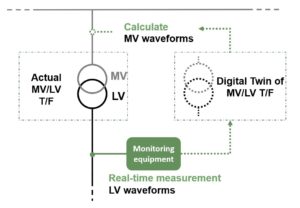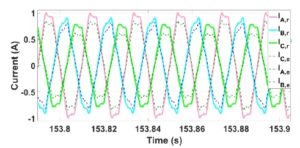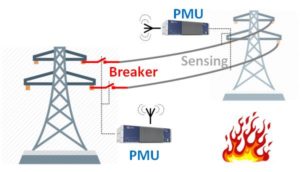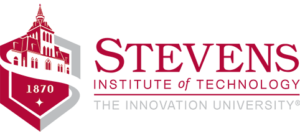January 2022

A few months ago, my work with Omid Mousavi from DEPsys SA on the Digital Twin of the Medium Voltage side of a Distribution Transformer based on Low Voltage side measurements was published in the IEEE Transactions on Power Delivery (preprint). I have been getting numerous hits on that paper plus some invitations for collaboration, so I thought I should blog a few thoughts about the subject a bit more broadly.
Let me start by describing the idea of this specific publication first. We want to monitor harmonics and system faults with adequate accuracy and, preferably, in real time throughout an electrical grid. However, medium and high voltage measurement equipment is costly and might require network disruptions to be installed. Using measurements on the lower voltage side of transformers (T/F) – LV for distribution T/F and MV for substation T/F – and relying on a model of its operation can answer both challenges, while serving the monitoring purposes. As you may read in the paper, the MV side behavior of a distribution T/F may be captured through LV measurements with the delay of a mere sample step (e.g. 0.2 ms at 5 kHz rate). Talk about real-time, right?


The bigger picture is that digital twins are purpose-driven. We define the needs of monitoring a phenomenon or range thereof, any challenges in the process, and engineer the infrastructure and the models required in that framework. The essence of digital twins lies in their ability to respond to real-time inputs and adjust the depiction of the asset or phenomenon in real-time, too. Some might say that they resemble a feedback control system, but for the purpose of monitoring.
The term “real-time” here though, is tricky. If the scope of the monitoring is electrical phenomena (e.g. transient faults), then the term implies sub-second detail. On the other hand, if the purpose is equipment ageing, then granularity of months might suffice. That been said, it is the subtext of real-time which is actually more important. The user or control process relying on the digital twin must be informed in-time to act upon the information. In the case of a T/F suffering an uncleared single phase fault to ground, there is a system operator or local utility that must respond and restore full operational capacity after the fault has occurred, yet fast enough. If the insulation of a breaker is nearing its replacement time, a few days (at least) of advance notice are necessary to plan maintenance actions.

At the moment, I am considering another digital twin for overhead transmission lines that are approached by a forest fire and must get disconnected in time. Unlike, the distribution T/F digital twin, the electrical model was not sufficient for the purpose and needed to be enhanced with additional details that made it ever more challenging and interesting. Still it seems to be able to detect the forest fire in sub-second times, thus meeting the monitoring purpose. I hope to be telling you more about it soon.
